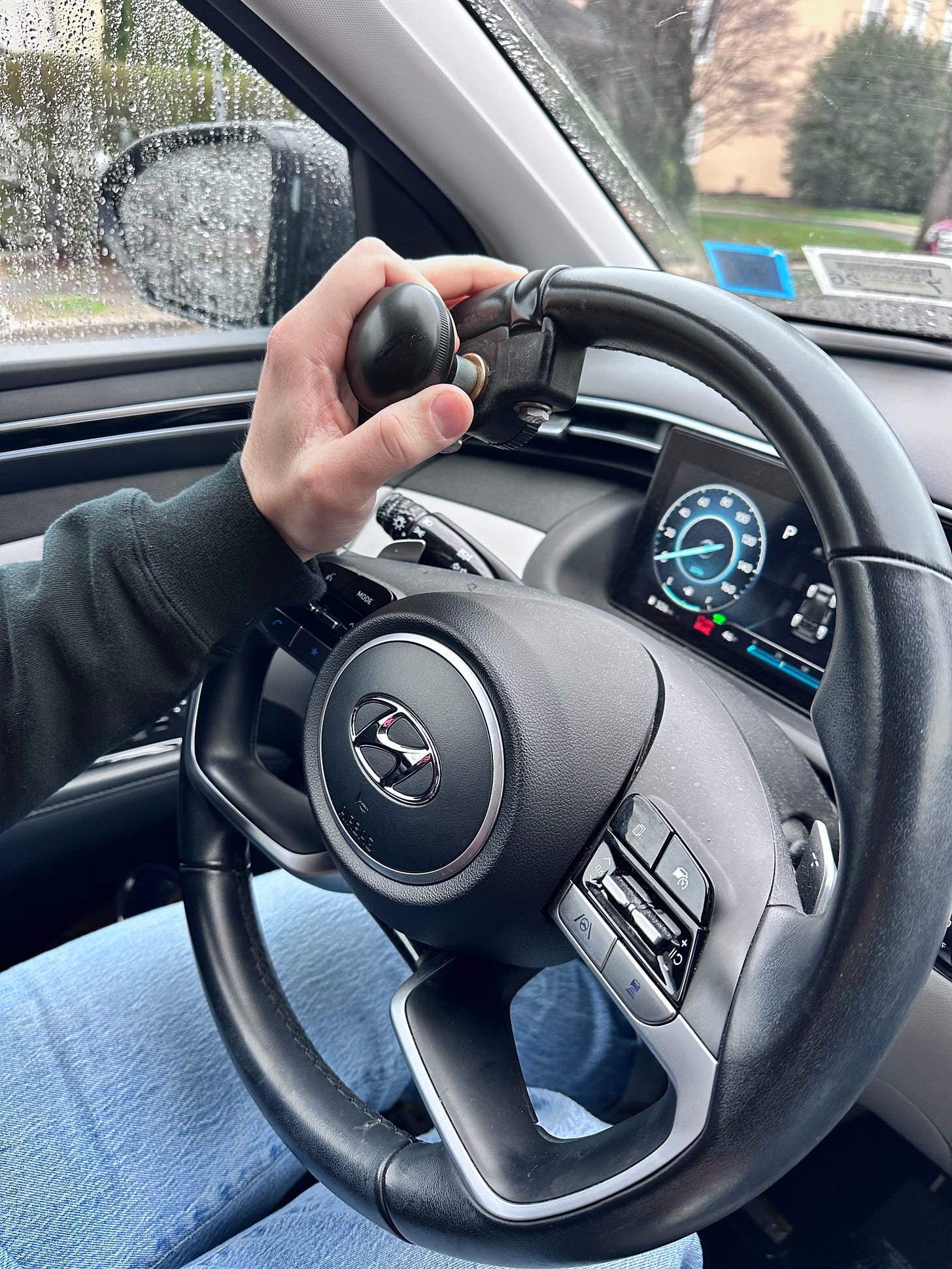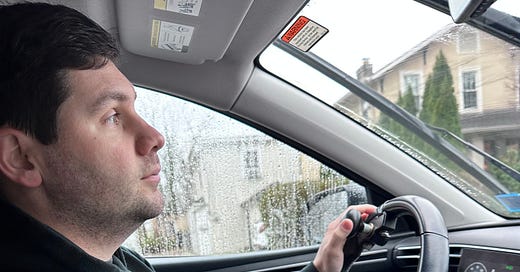Twelve Years Of Turning The Wheel Using One Hand As A Disabled Driver
In the car, I use a spinner knob mounted to my steering wheel and a left-side accelerator pedal

Note: I wrote this essay the summer of 2022 when my son Noah was 11-months-old. It’s about my relationship to driving and using adaptive equipment navigating roads as a disabled person with cerebral palsy of the right side. I’ve driven Noah to daycare hundreds of times since I wrote this and the little boy can now climb into his car seat by himself. Time is curious.
I scooped up my son Noah from the car seat with one hand after lowering the hat I was wearing so other parents wouldn’t see that I just cried in the car at drop-off. It had been a frantic morning getting him to daycare on time.
I was behind the wheel of a new car my wife Lisa and I had recently purchased and that Friday was the furthest I had transported my eleventh-month-old alone. Readying Noah then strapping him inside the car seat while Lisa was away for work had been complicated, and considered just like my entire relationship with driving. I’m a disabled parent with cerebral palsy who uses adaptive equipment to drive.
In the decade-plus I’ve been behind the wheel, I’ve steered through snowstorms, Hurricane Sandy and a tense trip home from the hospital with a newborn, yet the prickly task of finding a new car that suited my disability had exposed fresh complexities navigating New York roads with weakness and spasticity on my right side.
I knew looking for a new vehicle would be different once Noah arrived. Lisa and I had decided we would transition from a sedan to a SUV, making room for our son’s stroller and a brigade of baby accessories. However, I already had a list of requirements that should have made the car search less panic-inducing. I was almost confident. I discovered that I required a button panel I could press with my left hand instead of an automatic gearshift that was impossible for me to throttle with a spastic right hand after going through the car-finding process twice already. A push start ignition was a must since I can’t turn my right wrist.
What To Pack And Unpack Visiting A Childhood Home
Figuring Out How To Read To My Son’s Class As A Parent With Cerebral Palsy
I was well-prepared this time having already had too many uncomfortable conversations with salespeople about how I can’t test drive the automobile I was about to be stuck with for six years as I also need adaptive equipment installed to get behind the wheel. My disability can go unnoticed, although like in so many other circumstances, salespeople give a skeptical smirk when I offer my left hand to shake. Despite difficult exchanges, Lisa and I finally came across a 2022 Hyundai Tucson hybrid SUV with a button panel that worked for me at the fifth dealership we visited. Following grueling negotiations, the two of us decided to finance the SUV that was still over budget. Regardless, We needed a car immediately since our lease was up in two weeks and Noah had to be driven to daycare, doctor’s appointments and the park.
The next part was supposed to be easy. I called the local auto body shop that installed adaptive equipment because I required a left-side accelerator pedal and a spinner knob mounted to my steering wheel so I could drive with one hand while using my left foot. The shop had put this equipment in two of my previous cars and had always been accommodating. But I wanted to quit driving altogether by the end of the chat. The mechanics who specialized in the work had left the shop during the pandemic and the business no longer provided the installation services. They recommended a different shop, but they weren’t familiar with my disability.

When I called this other garage, the person I spoke to asked me to flip over my license. I always knew there were codes on the back noting that I drive with adaptive equipment, however the man on the phone told me that the codes I read to him didn’t match the markers for the equipment I was requesting. He said I needed to contact the Department of Motor Vehicles to get my ID updated before installing the adaptive equipment.
I never wanted to drive when I was young. I was terrified and committed to the idea that my friends were going to taxi me from my house to movies and parties indefinitely. When the suggestion of using a spinner knob and other adaptive equipment was presented to me in my teens I burst into a tantrum. I had hidden my disability from my friends and what would they say if they saw me cruising around with a knob on the steering wheel that truck drivers used in decades past? No way. I tried to learn how to drive without adaptive equipment when I was seventeen, but my right foot is spastic and I couldn’t keep it steady on the brake or accelerator. My right hand got stuck on the steering wheel. I was unable to make full turns and my brother-in-law was tired of pulling the emergency brake by the time we finished our practice session.
Finally, I found freedom when I got my license at twenty-two. It was one of my first steps accepting my disability. I had graduated college on a Friday and started my first full-time job in a New York newsroom the following Monday. A car was essential for commuting to the office and I was forced to overcome my fears fast. I found a local driving school that specialized in teaching people with disabilities to get behind the wheel a few months before work began. My instructor was patient and showed me how to drive with one hand. A few lessons in, using the left-side accelerator and knob just clicked. I experienced something I rarely did — I felt in control. This small cue ball-like device that helped me turn the wheel with one hand was my ticket to the larger world and I was no longer bound to friends and bus schedules.
That first summer, I spent hours joyriding in a little black sedan with a working CD player and power windows. I had done my best to prove to myself I belonged on the road by following every rule, and eventually overcompensating, as I drove slowly in the right lane on highways and stalled too long at stop signs. Nevertheless, I had the wrong designations on my license for my entire driving life. I still wouldn’t let friends in my car because I was a few years away from being transparent about my disability, but I mastered that knob. I turned the wheel with one hand effortlessly. There were flat tires, a plethora of parking tickets and gas I was afraid to pump myself. I found some courage to pull the pump and hold it in between the back of my right hand and chest while I unscrewed the cap. In time — the tickets were paid too.
A call to the DMV when I heard my license required an amendment for the SUV’s adaptive equipment sent me further into a tailspin. I was told I might need to retake my driving test. Not only did Lisa do all the parallel parking because she began getting nauseous when I went back and forth while trying to line up the mirror, I also no longer had a vehicle outfitted with adaptive equipment to operate during a test being that I already returned my leased car. Even taking the test might have been impossible.
I pleaded my case and relayed how many years I’d been on the road. The response was that I needed to come into the office for a manager to determine my license’s fate, but the woman mentioned that she didn’t know how I’d get out of a road test ten years after my first exam. The code for an accelerator left of brake is A, but I had V1 for a foot operated parking brake instead. The spinner knob designation, Z1, was accurate, but I should have noticed I didn’t drive with a foot operated parking brake.
I’m not sure how a different classification ended up on my license, but it had remained there during a time when I tried to ignore my disability. A few years before, I was too afraid to even Google the word cerebral palsy, let alone look up the codes on the back of my license.
Why I shouldn’t Ignore My Cerebral Palsy
Cooking & Disability: A New Cutting Board and Taming The Tomato
Reintroduction: A Substack on Disability, Parenthood and Everything Else
I arrived at the DMV with an arsenal of paperwork. In the back of a filing cabinet, I had even found the certificate from the driving school that showed I passed my first test. With an impassioned speech prepared, I took my ticket at the DMV and waited. The speech never happened. I was out of the building in twenty minutes with the codes on my license corrected. The manager behind the counter fixed the mistake on my license and I walked out a motorist again. I was lucky because someone else may have made a different decision which would have taken me off the road for months. Lisa drove home because I still hadn’t operated our new car, but later that month when the adaptive equipment was installed, I practiced in a parking lot while she cheered me on.
It took me days to be comfortable enough to transport Noah to school with Lisa in the passenger seat of our new SUV. On the morning I took him to school by myself, it was like I had never prepared my son for the day or brought him to daycare. By the time we reached the car, he hadn’t drunk his bottle and it took me four tries to fit a shirt over his head using one hand. Running around the house looking for everything he needed made me feel like an inexperienced parent. Without Lisa, I was untethered.
From carrying groceries inside to buttoning my shirt with one hand, many daily tasks are puzzles that have to be solved. Even figuring out I needed to pick up Noah from the car seat by putting my left hand underneath him required trial and error. A new adaptation in a life of adaptations.
Noah didn’t cry that morning, but tears arrived halfway to his daycare when I realized I forgot his tiny socks. A couple one-handed left turns later, I found comfort when Noah began to babble and point at the trees as we passed through streets I’d drive him down countless times.
Noah’s favorite song this week: Noah articulating “de-fense” is the best.
New York Times: With a Baby on the Way, It Was Time to Embrace My Disability
Writer’s Digest: Adaptations I Learned Writing a Memoir With Cerebral Palsy




I’m just catching up on some posts I missed having had a super busy April, and this was really interesting to me as I recently surrendered my driving licence after trying out various adaptations and finding myself unable to commit to what was offered. And my recent Substack post is all about this! Ultimately giving up my licence felt like the right decision for me, but it wasn’t easy. I’m really glad you have found something that works for you. 😊
Really great and super-inspiring post, Chris! This all sounds like it was very frustrating!!! Isn't it funny how sometimes we get all stressed out about something (in this case, justifiably so!), and then all the stuff we worry about ends up not being an issue? Glad you got someone in a good mood that day and it went smoothly.